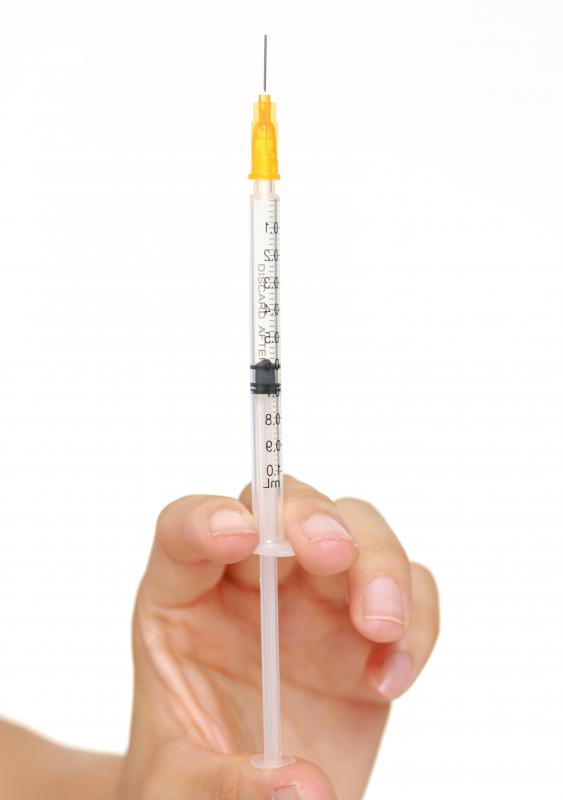At WiseGEEK, we're committed to delivering accurate, trustworthy information. Our expert-authored content is rigorously fact-checked and sourced from credible authorities. Discover how we uphold the highest standards in providing you with reliable knowledge.
What is an MDI Regimen?
Insulin-dependent diabetics have a range of treatments with insulin to choose from. Some are able to take one or two injections of a long-acting insulin each day, some use an insulin pump and some diabetics use the MDI regimen, or Multiple Daily Injections.
The MDI regimen works based on how the body uses insulin. The pancreas tends to produce a steady flow of insulin throughout the day, to maintain function. However, when a person eats something, the pancreas gets the message to produce more insulin to deal with the carbohydrates the person is eating. This is why a low-carbohydrate diet is often prescribed to help with diabetes management. In an insulin-dependent diabetic, though, the pancreas is producing little or no insulin. If the diabetic is a Type 2, his or her insulin resistance may be sufficiently severe that extra insulin is needed to overcome the resistance.

An MDI regimen generally uses two kinds of insulin: long-acting and rapid-acting. The long-acting insulin is called the basal insulin. Long-acting insulin generally provides for the body’s basic insulin needs for 12-24 hours. Short-acting, or bolus insulin, covers the body’s insulin needs for a meal. Basal and bolus insulin levels are determined by frequent blood glucose testing. Basal rates on an MDI regimen are often determined by measuring blood glucose throughout the night and the morning fasting reading. Once the basal readings are worked out, the diabetic then usually starts working on bolus numbers.

The MDI regimen allows a Type 1 diabetic to eat more freely than a Type 2 diabetic, although the MDI regimen can also allow a Type 2 more freedom than those not on insulin. This is because the diabetic “covers” the carbohydrates in his meals with extra, rapid-acting insulin which enters the bloodstream quickly and when administered properly, keeps the diabetic from having a blood glucose “spike” after a meal. To bolus properly, a diabetic will need to figure the approximate number of carbohydrates in the meal, and know his or her insulin-to-carbohydrate ratio. For instance, a standard figure is 1:15. That is, the diabetic takes one unit of bolus insulin for every 15 grams of carbs consumed. This figure is often determined on a trial-and-error basis, and for Type 2 diabetics with severe insulin resistance, the numbers will be much higher.

While an MDI regimen can be effective in managing diabetics, it does have the obvious drawback of multiple injections. Many diabetics have trouble finding “fresh” injection spots that also provide good absorption of the insulin. It can also be costly, when figuring the costs of insulin, syringes and needles, or insulin pens. The MDI regimen can also cause instances of hypoglycemia, or hypos (very low blood glucose levels), when too much insulin has been administered. Most diabetics are advised to keep glucose tablets, or some other form of rapidly absorbed sugar nearby, in case of a hypo. A hypo usually manifests with shaking, sweating, blurred vision, dizziness. A hypo is easily treated with sugar, but a diabetic should also keep a blood glucose meter on his person at all times, to test his blood in case of a suspected hypo.

While the MDI regimen is manageable for many diabetics, others decide to go with the insulin pump, which delivers a constant flow of rapid acting insulin. The decision to switch from one method to the other should never be taken lightly, and the diabetic should always do a great deal of research into both regimens. The diabetic’s doctor should also be consulted and should work with the patient, regardless of the regimen she chooses.
AS FEATURED ON:
AS FEATURED ON:














Discuss this Article
Post your comments